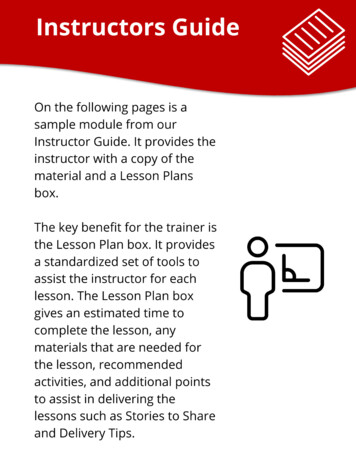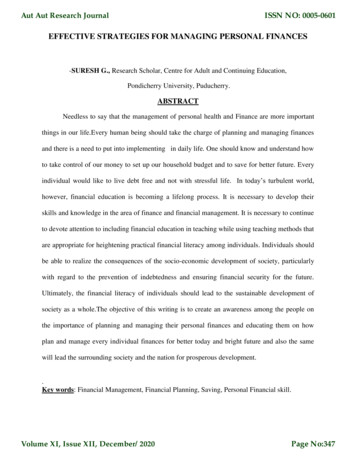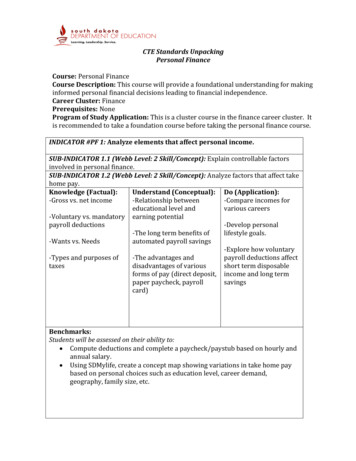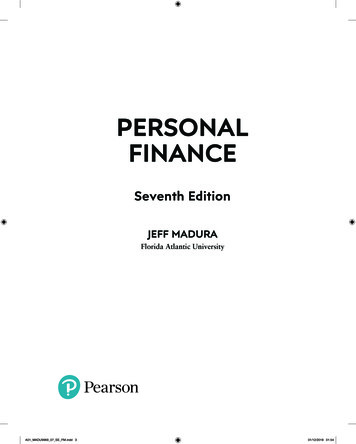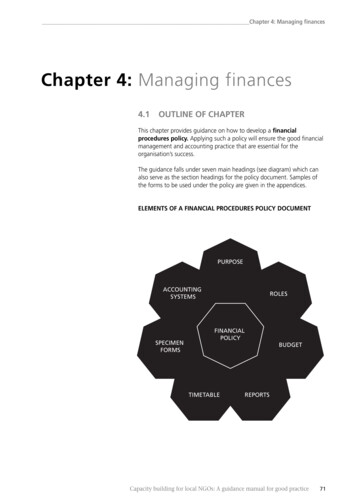
Transcription
Chapter 4: Managing financesChapter 4: Managing finances4.1OUTLINE OF CHAPTERThis chapter provides guidance on how to develop a financialprocedures policy. Applying such a policy will ensure the good financialmanagement and accounting practice that are essential for theorganisation’s success.The guidance falls under seven main headings (see diagram) which canalso serve as the section headings for the policy document. Samples ofthe forms to be used under the policy are given in the appendices.ELEMENTS OF A FINANCIAL PROCEDURES POLICY FINANCIALPOLICYBUDGETTIMETABLEREPORTSCapacity building for local NGOs: A guidance manual for good practice71
Chapter 4: Managing finances4.2PURPOSEThe financial procedures policy is critical for any organisation because itlays down procedures to ensure that the organisation’s resources (bothfinancial and material) are put to their proper use. It is important that thispolicy is well understood by staff and members of the governing body,because they are all responsible for good management of resources.Normally the governing body members and the Executive Director playthe key roles in developing such a policy, but it may be useful to involveother members of staff, in particular those with responsibility for finance.It is advisable to have a single, comprehensive policy document dealingwith financial management and accounting procedures, rather than aseries of separate ones. It will be easier to monitor its implementationand to update it.The policy document will outline the financial management procedures ofthe organisation and specify the roles and responsibilities of staff andgoverning body members. It is common to state in the document itselfthat it cannot be changed without the formal approval of the governingbody.Before embarking on the details of the policy it is useful to start with adiscussion about the purposes it will serve. A summary of the conclusionsreached might then form the preamble of the document, as in theexample presented below.EXAMPLE: PURPOSE OF FINANCIAL POLICYThrough rigorous adherence to the financial procedures outlinedin the policy document the organisation will be able to ensurethe following: The governing body will be able to show both funders andbeneficiaries that the organisation’s assets are safe, because it willbe able to show that checks and controls have been implemented. The organisation and its reputation will be protected againstfinancial mismanagement by staff or governing body members. The interests of the beneficiaries of the organisation, its employeesand the governing body will be protected. The relationship between the members of the governing body andthe staff in financial matters and their respective roles andresponsibilities will be clarified. There will be an appropriate segregation of responsibilities for theapproval and execution of expenditure. Financial decisions will be given appropriate consideration beforethey are taken. The relevant accounting regulations, standards and legalrequirements will be complied with.72Capacity building for local NGOs: A guidance manual for good practice
Chapter 4: Managing finances4.3ROLES AND RESPONSIBILITIESThe first thing to do when setting up an accounting system is to decidewho is responsible for what in terms of financial management. It is veryimportant that financial responsibilities are shared and clearlydemarcated.One of the most important principles of sound accountingmanagement is that all financial transactions should be preparedby one person and reviewed by another.The segregation of responsibilities means ensuring that the personnominated to make payments by cash or cheque should not be a chequesignatory, or be responsible for petty cash.For example, the person responsible for authorising the payment ofsalaries (Executive Director) should not be the person who actuallymakes these payments (Finance Officer). The person responsible forsigning a cheque for a petty cash top-up (Finance Officer) should notbe the person responsible for making payments out of the petty cash(the Administrator).The purpose of segregating responsibility in this way is to ensure thatchecks and balances are built into the system regardless of how few ormany staff an organisation employs.The next question to consider is the role of the governing body andtrustees in financial management, because the governing body hasultimate responsibility for ensuring that all the assets and finances of theorganisation are properly managed and that staff, including the ExecutiveDirector, are fully accountable to it. The basic accounting principlesshould be outlined in the governing document (see Chapter 2:Organisational governance). In addition, some governing bodiesnominate or select a trustee to act on their behalf as Treasurer.It is particularly important to have clear lines of responsibility at the mostsenior levels of the organisation, but all employees share responsibility forensuring that finances are secure. Below is some guidance about howthese responsibilities could be defined in a financial procedures policydocument. Some organisations also include the contents of the‘responsibilities of staff’ paragraph in all their employment contracts (seeChapter 5: Managing people).Capacity building for local NGOs: A guidance manual for good practice73
Chapter 4: Managing financesEXAMPLES: KEY FINANCIAL RESPONSIBILITIESResponsibilities of governing body trusteesThe trustees hold the organisation’s assets in trust for the beneficiariesand funders and are responsible for ensuring that they are used toachieve the aims for which the organisation was established. Trusteesare duty bound to ensure that proper account books and records arekept, that annual reports and accounts are prepared, and that theseconform to any relevant local legislation.It is the responsibility of the trustees and all staff to ensure that theorganisation’s financial systems and procedures are adhered to at alltimes and to report any discrepancies immediately: in the case of staff,to their line manager, and in the case of the Executive Director ortrustees, to the governing body.Responsibilities of the Executive DirectorIt is the responsibility of the Executive Director to ensure that allfinancial systems and procedures specified in the policy documentare in place and that the staff adhere to them, to report anydiscrepancies in a timely fashion to the Chair or Treasurer, and totake the appropriate disciplinary action against staff found to be inbreach. The Executive Director will rely on the assistance of theaccountant to ensure the smooth financial operation of theorganisation on a day-to-day basis.Responsibilities of staffBefore committing the organisation to any expenditure for goods orservices or to any financial liability, an employee must be satisfied thathe or she has the necessary authority. A breach of the organisation’sfinancial policies and procedures could be considered seriousmisconduct and could lead to disciplinary action.It is also important to outline clearly the more specific responsibilities ofthose charged with managing the organisation’s finances. The boxesbelow give examples.74Capacity building for local NGOs: A guidance manual for good practice
Chapter 4: Managing financesEXAMPLES: SPECIFIC RESPONSIBILITIESThe Chair or Treasurer oversees and monitors adherence to the financial procedures set outin this policy document provides advice and support to the Executive Director and governingbody on financial management issues represents the governing body on issues relating to the soundfinancial management of the organisation liaises with the appointed auditor and presents audited annualaccounts to the Annual General Meeting.Trustees approve financial systems, procedures and management approve annual budget and annual audited accounts monitor income and expenditure implement policy on loans, investments and reserves approve arrangements for insurance and risk management approve all salaries, new posts, appointments authorise all the organisation’s bank accounts and their signatories.The Executive Director presents accurate, timely and high quality financial information andreports to the governing body formulates the annual budget monitors financial outcomes against the budgets on a monthly basisand takes appropriate action facilitates the annual audit reports annually to the governing body on a competitive quotationprocess for all annual contracts for goods, services, insurance, etc ensures that all staff adhere to the financial procedures outlined inthe financial procedures policy document authorises petty cash top-ups against expenditure documented bythe Office Manager keeps abreast of any changes in financial legislation and regulationsaffecting the organisation directs and coordinates financial strategies and plans, linking theseto the annual work plan ensures adequate insurance to cover assets and liabilities checks records of incoming cheques and cash against bank statements banks incoming receipts at least weekly keeps the cheque book in an appropriate, secure and safe place.Finance Officer records all incoming cheques and cash and ensures the security ofthese until they are banked maintains an up-to-date record of all assets and regularly checksthat these are secure and well maintained prepares expenditure documentation for appropriate authorisation(see procedures) checks orders received against invoices and keeps records of ordersplaced but not yet received manages petty cash float, subject to cash count and checks by theExecutive Director whenever a top-up is requested keeps the assets registers.Capacity building for local NGOs: A guidance manual for good practice75
Chapter 4: Managing financesThese responsibilities should be reflected in the terms of reference ofthe governing body (see Chapter 2) and in the individual jobdescriptions of staff (see Chapter 5). If the organisation employs anaccountant, then some of the responsibilities of the Executive Directoroutlined above may be delegated to this post-holder.4.4ACCOUNTING SYSTEMSThe third part of the financial procedures policy document will outline theorganisation’s systems and procedures for ensuring robust financialmanagement. Below is a checklist of questions to consider when framingthis.CHECKLIST: KEY DECISIONS TO TAKEFRAUD How will the organisation deal with cases ofpossible fraud? To whom will staff report cases of suspectedfraud? What action will be taken if a member of staffis found to have been involved in fraud?SYSTEMS Will the organisation use a computer accountssystem or a manual system (specify details)?BANKING How will the organisation organise andmanage its bank accounts? Current account details Minimum requirements for cheque signatories How will the organisation ensure that the bankaccounts are secure?CASH POLICY How will cash transactions be managed?ASSETS How will fixed and consumable assets bemanaged?VEHICLES76 How will the organisation ensure that its vehiclesare used and maintained appropriately?STAFF How will staff expenses and entitlements bemanaged? What is the staff salary structure? What expenses or other entitlements are staff,governing body members, volunteers entitledto?PURCHASING How will the organisation manage purchasingand procurement for office and project items?INSURANCE What type of insurance is needed (what doesthe law require) for staff, premises, assets andvehicles?Capacity building for local NGOs: A guidance manual for good practice
Chapter 4: Managing finances4.4.1 POLICY ON FRAUDAll governing body members and staff employed by the organisation have aduty to ensure that they safeguard its financial assets. For this reason it isimportant to have a clear policy spelling out what action will be taken in thecase of suspected fraud and the lines of authority that have beenestablished for dealing with such cases.As soon as a staff member has any suspicion of fraud in any area of theorganisation’s work, he or she needs to know to whom to report it. Usuallythe policy will specify that such concerns should be taken, in the firstinstance, to the Executive Director who in turn will report to the governingbody, including the Chair and/or Treasurer. However, concerns relating tothe financial conduct of the Executive Director or that of a trustee areusually taken directly and explicitly to the Chair of the governing body.In any circumstance where fraud is suspected or discovered, the policydocument must specify that prompt legal action will be taken and thatfraud is sufficient grounds for the dismissal on the grounds of grossmisconduct of a staff member (see Chapter 5: Managing people). Theseprovisions can provide an important deterrent.4.4.2 SYSTEMS OVERVIEWIt is also important to specify in full in the policy document how theorganisation will record its financial transactions, including petty cash. Someorganisations will keep manual records of their transactions; others willuse a computerised accounts system.Under the manual system a separate bank book must be maintained foreach bank account, as well as a cash book for the main cash float. Thesebooks are usually referred to as ledgers.Two different systems can be used: a single entry ledger system or adouble entry ledger system. (See Appendices 1 and 2 for examples ofthese.) However, these should NOT be treated as forms because loose piecesof paper can easily be lost. The format should be used in the books ofaccount (for bank and cash) or on a computerised system.Generally speaking, very small organisations can use a single entry systemeasily, but once their accounts become more complex it is best to start usingthe double entry system. It is advisable for an organisation to use a doubleentry system if it makes more than about 20 payments a month because itshows more specifically how the money was spent and facilitatesmonitoring. Basically, the double entry ledger is a more sophisticated way ofrecording income and expenditure by entering each transaction twice (iedouble entry) to make it easier to check how much has been spent againsteach budget heading.In the double entry system payments and receipts are detailed in date orderwith receipts on the left and payments on the right. Each transaction mustbe supported by a receipt or payment voucher. The reference number mustbe recorded on the form. Cheque numbers must also be recorded. Therelevant budget head or account code must be entered against eachtransaction.Capacity building for local NGOs: A guidance manual for good practice77
Chapter 4: Managing financesA single entry ledger system must include: the date of the transaction a description of how the money was spent or received a voucher number an ‘amount in’ or ‘amount out’ column representing income orexpenditure the current balance, calculated by simply adding or subtracting thetotal from the previous current balance. At the beginning of eachnew page, the balance carried forward is entered from the bottomof the previous page. In the double entry ledger system the current balance iscalculated by subtracting total expenditure from total income. The budget codes are entered across the top of the ledger: budgetsubheadings can be included under each main heading as desired. As with the single entry ledger system, each transaction is enteredin the ‘amount’ column but income is listed separately in thecolumn on the left and expenditure in the column on the right. After the amount has been entered in the appropriate column it isentered again under the appropriate budget heading orsubheading. This means that at the month end, it is easy tocalculate how much has been spent under each budget heading.4.4.3 BANKING REQUIREMENTSAlthough many local NGOs do not have bank accounts when they beginoperations, it is essential to ensure that such an account is opened at theearliest opportunity (where possible). As many of the organisation’sfinancial transactions as is realistic should take place through the bankaccount rather than through cash transactions. It is much easier tomonitor bank transactions and a bank is the safest place in which to keepfunds.The policy document will need to specify the full details of any bankaccounts held in the name of the organisation.CURRENT ACCOUNT DETAILSAccount type:Name and address of bank:Account name and number:78Capacity building for local NGOs: A guidance manual for good practice
Chapter 4: Managing financesCheque signatoriesIt is good practice to require that all cheques are signed jointly by at leasttwo of the named signatories and to specify that for cheques over X amountone of the signatories must be the Chair or Treasurer of the governing body.Indeed, it is prudent to specify that any cheque above X amount must beapproved by the governing body at one of its routine committeemeetings. This will ensure that no cheques for large amounts of moneyare cashed without full knowledge and authorisation.It is essential to spell out clearly the minimum sums for which differentsignatories are empowered to sign cheques and who these signatoriesmust be, as outlined in the example below.EXAMPLE: CHEQUE SIGNATORY REQUIREMENTSUp to maximum sum of XFrom X to Y sumAbove Y sumExecutive DirectorExecutive Director and named governing bodysignatory or two governing body signatoriesGoverning body signatory and Treasurer or Chairof governing bodySee Appendix 3 for an example of an authorised signatories list.In addition to clearly specifying cheque signatory requirements fordifferent levels of payment, it is essential to have clear procedures toguide the signatories as shown in the box below.PROCEDURES: CHEQUES All cheque payments will be summarised quarterly and madeavailable for inspection by the governing body. Cheques made payable to an account signatory must not besigned by that signatory. All cheque expenditures will be recorded on the accounts systemand cross referenced to a cheque number, with the nature of thepayment clearly identified. All cheque book stubs will be completed at the time of paymentand retained according to the auditors’ requirements. No cheques will be signed without the corresponding invoice, orother documentary evidence of the nature of the payment. Blank cheques must never be signed. An individual must be in the formal employment of theorganisation or elected to the governing body as a trustee for aminimum of three months before becoming a signatory. Thegoverning body will make any necessary arrangements to coversignatory responsibilities during the initial stages of employmentor trusteeship.Capacity building for local NGOs: A guidance manual for good practice79
Chapter 4: Managing financesIt is also important to think clearly about practical issues such as thelogistics involved in meeting the minimum requirements for signatories.For example, if the Chair of your governing body lives far away fromthe office, it might be better to have the Treasurer who lives nearby asa named signatory of cheques above X amount.However, if the governing body meets regularly it should be possible forlarger cheques to be signed before or after the committee meetings,provided that this is planned ahead of time.Bank securityThe policy document should specify the procedures to ensure that allfunds kept in the bank are secure at all times, as outlined in the boxbelow.EXAMPLE: BANK SECURITY RULES The number of bank accounts must be kept to a minimum. Arrangements must be made with the bank to confirm paymentsover a given amount before they are cleared. Bank transfers must be made only by cheque and not by letter, fax,email, telephone or internet. All bank documentation, such as examples of the signatories’signatures, must be kept in a secure file together with otherfinancial records. It is advisable to ensure that any bank accounts are in the name ofthe organisation rather than in the names of individuals. Two members of the governing body (including the Chair or Treasurer)must authorise the opening and closing of every bank account.Any deposits of either cash or cheques into the bank must beauthorised and recorded. (See Appendices 4 and 5 for suggestedformats for recording deposits.)4.4.4 CASH POLICYThe governing body should decide in principle the ceiling on theamount of petty cash to be maintained in the office at any one time.This amount should be specified in the financial procedures policydocument. It is the responsibility of the Executive Director to ensurethat these limits are adhered to. Petty cash float levels will usually beenough to last a week. The amount of the petty cash float is bestfixed. When it falls below a certain level it must be topped up from thebank, to restore it to its original level.When the petty cash float becomes low, a petty cash top-uprequest form (see Appendix 6) must be completed by the FinanceOfficer and authorised by the Executive Director. The same personcannot prepare and authorise a petty cash top-up request form.It is also advisable to set some authorised expenditure limits onpetty cash (see Appendix 7 for a specimen form). These need to beunderstood by everyone on the staff team and kept on file as a record.80Capacity building for local NGOs: A guidance manual for good practice
Chapter 4: Managing financesCash floatsFor salary advances and operating or travel floats, it is essential to ensureat minimum that: An up to date float register is kept. Limits are set on the size of a salary advance or cash float. Authorisation procedures are clearly defined. All staff members understand clearly the method of repayment or, inthe case of salary advances, deduction. Receipts or a receipt book are used to back all transactions.A float is an amount of cash given to an individual to cover expenditurewhile away from the office or to purchase items that cannot be paid forby cheque. It is important to ensure that all floats given out are properlyaccounted for. To do this, a float register must be maintained (seeAppendix 8). The left-hand side of the register records the floats givenout. The right-hand side lists floats returned and expenditure accountedfor. The final column shows the value of floats outstanding.The register is simply a means to ensure that all floats have beenaccounted for. The floats also need to be recorded in the accounts. Thepayment of the float must be coded to personal floats on the expenditureside of the cash or bank book. When the residual float is returned withreceipts, the total value of the float is cancelled by showing the fullamount of the float on the income side of the cash or bank book. Theexpenditure is shown on the payments side, coded to the relevantaccounts.Inevitably there will be circumstances when it is necessary and prudentfor an organisation to provide a member of staff with a cash advance forwhich there is no supporting documentation. In addition to salaryadvances, which are recorded on the salary sheet (see 4.4.7 below), it canbe helpful to have a page at the back of the cash book that records theamount of any advance taken. The person receiving the advance shouldsign for it, and no new advances can be given to the same individual untilthe last one has been cleared. Cash advances are not encouraged, andthe normal procedure for cash disbursement should be used wheneverpossible.Surprise cash countTo ensure that petty cash is being managed properly, it is a good idea forthe Treasurer to undertake a surprise cash count periodically. TheExecutive Director should also do this from time to time. This may bedone using the cash count form (see Appendix 9) which is also used forthe month end accounts (see 4.6 below).Whoever is carrying out the count asks the Finance Officer for the currentbalance as stated in the cash book and enters this at the top of the form.A physical count of all the petty cash in the safe or cash box is then doneand entered by denomination on the form. If the cash balance does notmatch the cash balance in the accounts, the reasons for this need to beexplained on the form.The example below outlines some best practice guidelines for petty cashmanagement.Capacity building for local NGOs: A guidance manual for good practice81
Chapter 4: Managing financesEXAMPLE: CASH MANAGEMENT GUIDELINES No more than [specified amount] will be held as a petty cashfloat in a locked cash box at any one time. This will be managedby [named person who should NOT be a cheque signatory]. All cash payments will be made from the petty cash float, not bythe retention of incoming money. All claims from the petty cash float will be backed up bysupporting documented evidence, which is authorised bysomeone other than the claimant. Petty cash top-up requests must be made by the person withresponsibility for petty cash, showing that expenditure hasreached a level where funds need to be replenished to the valuerequested. A cheque signatory [or signatories] will check andapprove the receipts and then sign the cheque. Cheque, rather than petty cash, payments must be madewherever possible for goods or services over the value of[specified amount]. The balance of petty cash kept in the office will be monitoredperiodically by the Executive Director or Treasurer.4.4.5 FIXED AND CONSUMABLE ASSETSThe difference between consumable and fixed assets is defined in the boxbelow.CONSUMABLE ASSETS Items that get used up over time such as rent, insurance, stationery,paper and other suppliesFIXED ASSETS Office equipment, office furniture, personal computers, laptopcomputers, printers, photocopier, motor vehiclesSome organisations will need to account for the assets they have in theoffice or for office use and those which are donated or loaned toprojects. Different registers should be kept for each as follows: Register A: fixed assets Register B: consumable assets Register C: assets purchased for a project Register D: assets of a finished project.Specimens of these registers are appended (see Appendices 10-13). Inmanaging and accounting for assets the following example sets out theminimum standards of good practice.82Capacity building for local NGOs: A guidance manual for good practice
Chapter 4: Managing financesEXAMPLE: FIXED ASSET MANAGEMENT POLICYRegistrationAll fixed assets with a purchase price over a specified amount must beregistered by the [eg Office Manager] in a register and a copy of thepurchase invoice must be kept with the register. The register must beupdated monthly to include newly purchased assets.Physical auditIdentification of fixed assets must be undertaken under the supervisionof the Treasurer or Chair of the governing body in the followingcircumstances: in the month before the end of the financial year during an audit visit during the handover of the Executive Director to a successor.Lost or stolen itemsThe Chair or Treasurer of the governing body must be advised of anylost or stolen items. Theft is a disciplinary offence.DepreciationDepreciation is set at a level of three years for computers and printers,10 years for office furniture and five years for vehicles. Depreciationwill be calculated when end of year accounts are prepared and asadvised by the auditor.DisposalWhere an asset is no longer required its sale or disposal must beauthorised by the Chair or the Treasurer of the governing body.Retained assetsAssets held beyond the write-off period must be retained on theregister and given a nominal value.Private use of the organisation’s computers or photocopier ispermitted in special cases, as determined by the Executive Director. Thestaff member bears the full actual cost. Should a movable asset bedamaged or lost while in the care of an employee for private use, theorganisation may ask the employee to bear the full cost of repair orreplacement.Most of the procedures for managing consumable assets will be verysimilar to those for fixed assets.Capacity building for local NGOs: A guidance manual for good practice83
Chapter 4: Managing financesEXAMPLE: MANAGEMENT OF CONSUMABLE ASSETSRegistrationAll items with a purchase price over a specified amount must beentered in a register. This will be kept by the Office Manager [or otherspecified post holder] and updated monthly.Physical auditAs for fixed assets (see box above).Depreciation is not applied to consumable items.Disposal must be authorised by the Executive Director and reported tothe governing body at its next meeting.Private useAs for fixed assets (see box above).An inventory statementIn addition to the assets, organisations will have expendable and nonexpendable supplies. Expendable supplies are similar to consumableassets but not of high value (valued below a specified amount andtherefore not included in the register of consumable assets). Nonexpendable supplies are similar to fixed assets but of less financial worth,for example filing in-trays for the office or wheelbarrows and hoes for aproject. As these items will not be covered by assets policy, an inventorystatement is necessary. This should cover the following areas: How does the organisation register expendable and non-expendablesupplies? Who can use which supplies and under whose authority? How are the supplies monitored? What action will be taken when supplies are damaged or lost?4.4.6 MANAGING VEHICLESA vehicle is one of the most costly fixed assets that an organisation hasand must, therefore, be carefully managed. The box below raises somekey questions to guide discussion and decision making about vehiclemanagement.84Capacity building for local NGOs: A guidance manual for good practice
Chapter 4: Managing financesVEHICLE MANAGEMENT Who must authorise the use of vehicles? For what purposes can an NGO vehicle be used? For example, ispersonal use by staff permitted? Who is permitted to drive the vehicle? Are partner organisationsand ot
Chapter 4: Managing finances _ 76 Capacity building for local NGOs: A guidance manual for good practice These responsibilities should be reflected in the terms of reference of the governing body (see Chapter 2) and in


